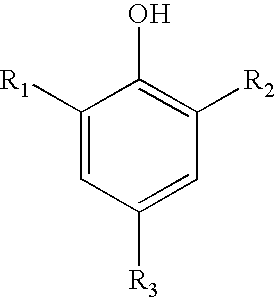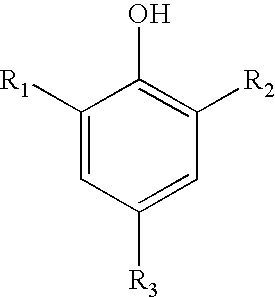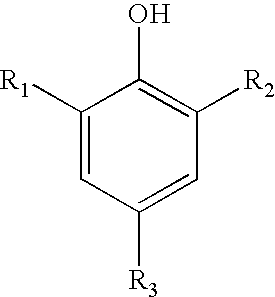Sulfonated nitrophenols as polymerization inhibitors
a technology of sulfonated nitrophenol and inhibitor, which is applied in the direction of other chemical processes, organic chemistry, chemistry apparatus and processes, etc., can solve the problems of loss of monomer, inability to fully inhibit and retard polymerization, etc., to achieve the effect of superlative inhibitory and retarder capability, high efficiency and low cos
- Summary
- Abstract
- Description
- Claims
- Application Information
AI Technical Summary
Benefits of technology
Problems solved by technology
Method used
Image
Examples
example 1
[0125] A quantity of 471 grams of a 17% HNO3 solution was placed in a round bottomed flask, equipped with an overhead stirrer, thermometer, addition funnel, and reflux condenser, and heated to 80° C. To this acid, a portion (162 grams) of sulfonated o-sec-butylphenol, made by the sulfonation of 300 grams of o-sec-butylphenol (OSBP) with 280 grams concentrated H2SO4 at 84° C., was added. The addition was subsurface and dropwise. The separation of reaction mixture resulted in two layers. The upper (aqueous acid) layer (509 grams) was separated from the lower (2,4-dinitro-o-sec-butylphenol) layer (104.6 grams) and 464 grams was evaporated in a 2 mm Hg vacuum at a temperature not exceeding 30° C. for 75 minutes. This residue (173 grams) was transferred into a separatory funnel. Recovery of the upper (organic) layer resulted in 37.1 grams of a mixture containing 4-hydroxy-5-sec-butyl-3-nitrobenzenesulfonic acid and 2-hydroxy-3-sec-butyl-5-nitrobenzenesulfonic acid.
[0126] The styrene inh...
example 2
[0128] A mixture of 4-hydroxy-5-sec-butyl-3-nitrobenzenesulfonic acid and 2-hydroxy-3-sec-butyl-5-nitrobenzenesulfonic acid, produced at plant scale, was tested in the procedure described in Example 1 at a concentration of 500 ppm. This material also contained 21% of dinitro sec.-butyl phenol (DNBP). During the steady stage test, 0.0004% polymer was formed, while the shut off test resulted in 0.038% polymer after one hour.
[0129] As a comparison, when DNBP was tested alone using the same procedure, the steady state polymer formation was 0.11% while the 1 hour feed shut off revealed 1.18% polymer.
example 3
[0130] Three hundred grams of OSBP was sulfonated with 280 grams of 98% sulfuric acid as described in Example 1. Two hundred grams of this material was used for nitration with an HNO3:OSBP molar ratio of 1.6:1 using the following procedure.
[0131] Nitric acid (35%; 171.4 grams) was charged into a round bottomed flask and to it the 200 grams of sulfonated OSBP was added dropwise in two hours at 40° C. The mixture was then transferred into a separatory funnel where two layers were formed. The 151 grams of bottom layer was identified as 40% sulfuric acid while the top (organic) phase was recovered as a 1:1 blend of DNBP and mixture of 4-hydroxy-5-sec-butyl-3-nitrobenzenesulfonic acid and 2-hydroxy-3-sec-butyl-5-nitrobenzenesulfonic acid.
PUM
| Property | Measurement | Unit |
|---|---|---|
| Time | aaaaa | aaaaa |
Abstract
Description
Claims
Application Information
 Login to View More
Login to View More - R&D
- Intellectual Property
- Life Sciences
- Materials
- Tech Scout
- Unparalleled Data Quality
- Higher Quality Content
- 60% Fewer Hallucinations
Browse by: Latest US Patents, China's latest patents, Technical Efficacy Thesaurus, Application Domain, Technology Topic, Popular Technical Reports.
© 2025 PatSnap. All rights reserved.Legal|Privacy policy|Modern Slavery Act Transparency Statement|Sitemap|About US| Contact US: help@patsnap.com



